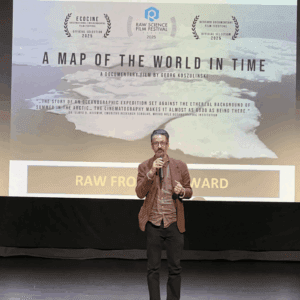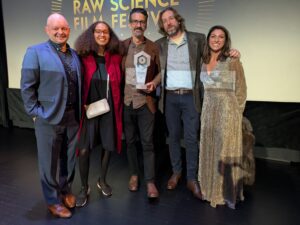
Nicholson School of Communication and Media professor Georg Koszulinski debuts his feature documentary A Map of the World in Time at the Raw Science Film Festival.
By: Majdulina Hamed | Published November 7, 2025
This month, the award-winning filmmaker and associate professor in the Nicholson School of Communication and Media (NSCM), Georg Koszulinski, is celebrating the world premiere and winning the Frontier Award of his latest feature-length documentary, A Map of the World in Time, at the Raw Science Film Festival (RSFF) in New York City. The festival, which brings together scientists, filmmakers, and storytellers from around the world, celebrates the best science storytelling across an array of disciplines.
Funded by the National Science Foundation, A Map of the World in Time explores the connection of science, art, and human endurance through an expedition into the Arctic Circle aboard the R/V Neil Armstrong. The film has also earned international recognition, recently receiving “Best Documentary” at the Bedford Documentary Film Festival in the United Kingdom.
Koszulinski shared that premiering the documentary at the Raw Science Film Festival is both an honor and an opportunity to engage with a global audience.
“It’s an incredible honor and a wonderful opportunity to showcase the film to an international audience,” Koszulinski says. “This festival will help us shepherd the film out into the world, so it’s a great launching pad. I’m also looking forward to hosting a workshop with the scientists who co-produced the film with me. It will be a wonderful reunion with discussions, and updates on current and future projects.”
“On the surface level, it’s about a team of scientists working alongside the mariners who guide their ship into the far reaches of the Arctic, deep into Greenlandic waters,” says Koszulinski. “The team collected sediment cores from the seafloor to study patterns of melting at the end of the last Ice Age; work that provides critical insights into warmer temperatures.”
Koszulinski shares how this film also takes a closer look at the effect that intense scientific research has on its scientists and mariners.
“There is a human cost involved in this scientific exploration,” says Koszulinski. “I think the film also becomes a meditation on the wages of knowledge. As we go deeper into the Arctic and our time at sea, we gain insights into the lives of the people who do this work, and the toll it takes.”
He says filming A Map of the World in Time presented immense technical and emotional challenges. Over 34 days at sea, Koszulinski and Assistant Director Janneke Wade-de Jong lived and worked alongside the crew, capturing the story amid rough seas, relentless noise, and isolation.
“It was an incredible experience getting to know the crew of the Neil Armstrong and the science party on board,” says Koszulinski. “Sometimes it felt like being in a science fiction world. We didn’t see land for weeks, and depending on sea conditions, even getting steady shots was a challenge. But that’s part of what made this project so meaningful.”

Photo courtesy of Georg Koszulinski: Pictured left to right is Producer and Chief Scientist Rob Hatfield (UF); Assistant Director, Janneke Wade De Jong; Director/Producer Georg Koszulinski; Producer/Co-PI, Brendan Reilly (Columbia U); and Producer Co-PI Shannon Klotsko (UNC-Wilmington)
In addition to his filmmaking career, Koszulinski is also a novelist, having earned the Raven Chronicles Press’ Keepers of the Fire Prize for Fiction (2024) for his novel Future X, with his second novel Notes from Lunar Underground forthcoming from Broken Tribe Press.
“I think my work as a filmmaker has influenced my writing more than the other way around,” he explained. “Writers are like proto filmmakers; they create images with words. Both forms let us explore inner worlds, but writing allows for a kind of depth that visual storytelling sometimes can’t reach.”
As a faculty member at NSCM, Koszulinski integrates his professional experience into teaching. He believes that filmmaking and education are deeply intertwined.
“Teaching keeps me tuned in,” he says. “I’m working alongside my students, exploring similar challenges and possibilities. It helps me stay productive and grounded. My students come from all over the world, and their creativity and perspectives are incredibly inspiring.”
He also offers advice for students interested in documentary filmmaking.
“First, study the form and all its modalities: narrative, experimental, documentary, and animation,” he says. “Documentary is a narrative art form with its own evolving possibilities. Knowing its history, traditions, and ethical considerations is vital to creating meaningful work.”
With A Map of the World in Time premiering at RSFF and streaming soon on Amazon Prime, Apple TV, and Proquest, Koszulinski continues to bring science and storytelling together for audiences worldwide. The film’s success reflects his dedication to bridging art and inquiry, and to mentoring the next generation of filmmakers at UCF.
“I’m looking forward to the discussions at the festival and reconnecting with the team who made this project possible,” says Koszulinski. “This is not just a film about science, it’s a film about people, discovery, and the pursuit of knowledge.”